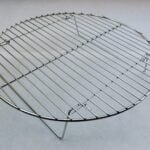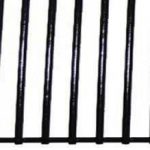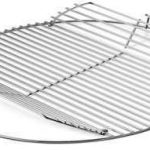The Definitive Guide to the Best Grill Grates (1 Article)

Which grill grate is best: stainless steel, cast iron, enamel coated, plated wire, or cast aluminum? The answer may surprise you.
Before taking a look at the different grill grates and considering pros and cons, you really should read my article busting the myth of grill marks. It discusses how to get the perfect surface color on your meats, a rich, dark brown color from edge to edge with no tan in between. Essentially, no cross-hatched grill marks. That’s max flavor, just as you can see on the surface of this grilled ribeye.
Click Here To Search Our Reviews And Ratings Of BBQ Tools, Toys, And Accessories
Yes, I know you’ve been indoctrinated all your life to start drooling when you see grill marks, but the truth is that grill marks mean much of the meat’s potential has been lost. Tan meat is meat that has less flavor than brown meat. So the goal should be an even dark brown all across the surface.
When buying a new grill, you might want to replace the grates to get the best browning on your meat. The conventional thinking on gridirons focuses on their ability to hold and transmit heat. That’s why there is a mystique about cast iron grates. They absorb and hold a lot of heat, and they brand the meat surface with that heat, creating dark sear marks. But I don’t want my grill grates to cook just parts of my meat.
Grill marks mean that only about 1/3 of the surface has been altered by the magical Maillard reaction, the process by which tan, dull meat is transformed to a brown, intensely flavorful crust. I want the radiant heat of the fire below, accompanied by smoke and combustion gases, to do the job. If I want the metal itself to sear my steaks I could do it better in a frying pan. On a grill, I want an evenly-cooked surface, not black stripes on the surface.
Worse, thick cast iron grates with little space between them block smoke from contacting the meat surface. Smoke is one of the main reasons we cook outdoors, isn’t it?
Think about the Brazilian steakhouse where everything is cooking on rotisseries. Waiters come to your table with the meat still on the spear and cut thin slices, not more than 1/4″ thick from the surface of the meat. Then the meat goes back over the coals until the surface browns again. The whole purpose of the system is to give you an evenly browned surface with medium rare meat immediately below. The meat is delicious, and there isn’t a grill mark in sight.
OK, sometimes grill marks do come in handy. When you are cooking thin or small foods like skirt steak, asparagus, kabobs or shrimp, it is almost impossible to get dark brown surfaces with just radiation or convection before the center is overcooked. The only thing that works is conduction. And that means grill grates that transmit heat well. That’s why my two favorite grill grates are polar opposites. The best solution for both gas and charcoal grills? For gas grills, I recommend GrillGrates (TM), and for charcoal grills, thin stainless steel grates get the job done.
One last thing: When you get a new grate, firing up the grill with the grate in place for about 30 minutes without food in order to burn off any grease, dust, or manufacturing byproducts. Your guests will thank you.
The Smokenator Hovergrill Expands Your Grill’s Cooking Capacity
Made by the Smokenator people, this is a quality stainless steel grate with legs can do three great things for your cooking.BBQ Dragon Spin Grate Makes Charcoal Grilling Easier
The BBQ Dragon Spin Grate rotates 360 degrees, making cooking on round kettle grills much simpler. Spin it to avoid flareups or easily switch between direct and indirect heat. The grate is hinged so you can easily add wood or charcoal, or adjust your fire without removing the grill grate. Read our full review.
How to Keep Food From Sticking to Your Grates
Don't you hate it when food sticks to your grill grates? This article explains how to prevent it: keep your grill grates clean and use the right temperature for the food you're cooking. Maybe lubricate the food (not the grates) with some oil. Some fish baskets and grill toppers may also help prevent sticking.Thin Porcelain Enamel Coated Grates Work Reasonably Well
A sturdy porcelain enamel coating is applied to a variety of metals of different weights. With proper care, these grill grates will work well and last for years.Chrome or Nickel Plated Wire Grates Work Well And Are Cheap to Replace
Yes, nickel plated steel grill grates warp under extremely high heats and eventually, the plating chips off, they rust, and you've got to pitch them. But they're so cheap that replacing them is a cinch. If you have a Weber Kettle, I recommend upgrading to the hinged grates so you can easily add more coals and wood.Thin Stainless Steel Is Durable and Does a Great Job
Stainless steel grill grates can be made from thin or thick rods, but I prefer the thin ones that allow more radiant heat through, especially for charcoal grills. The problem with thick rods is that they block radiant heat and make large dark grill marks.Thick Enameled and Stainless Steel Bars Don’t Let Through Enough Radiant Heat
As with cast iron, thick enameled stainless steel grill grates retain and transmit a lot of heat, making big bold grill marks: but that's not what we want. They're too thick to let through maximum radiant heat from the fire. That radiant heat is really what we're after when trying to create great grill flavor.Tempered Expanded Steel: Best for Cages and Fences, Not Grills
Here are the main strengths of tempered expanded steel grill grates: they are inexpensive and lightweight. Yes, they also make diamond shaped grill marks without having to rotate the meat, but grill marks are not the holy grail of great tasting meat. The truth is, there are better grill grates available.Cast Iron Grill Grates: Don’t Bother
Cast iron fry pans and griddles can become non-stick with use, so many people are under the misimpression that cast iron grill grates are also non-stick. They are not. Cast iron grill grates are more trouble than they are worth.Grill Grates: Teflon and Non-stick Coatings
Their best feature is that they clean up easily, with soap and water, and can even go through the dishwasher.Related articles
- How to Keep Food From Sticking to Your Grates
- Ratings And Reviews Of Hundreds Of Grills, Smokers, Hog Roasters, And More (8 Pages, 19 Articles)
- BBQ And Kitchen Tools, Toys, And Accessories Rated And Reviewed (23 Pages)
- Grill It In A Cast Iron Skillet (10 Recipes, 3 Pages, 2 Articles)
Published On: 5/22/2019 Last Modified: 6/24/2024












High quality websites are expensive to run. If you help us, we’ll pay you back bigtime with an ad-free experience and a lot of freebies!
Millions come to AmazingRibs.com every month for high quality tested recipes, tips on technique, science, mythbusting, product reviews, and inspiration. But it is expensive to run a website with more than 2,000 pages and we don’t have a big corporate partner to subsidize us.
Our most important source of sustenance is people who join our Pitmaster Club. But please don’t think of it as a donation. Members get MANY great benefits. We block all third-party ads, we give members free ebooks, magazines, interviews, webinars, more recipes, a monthly sweepstakes with prizes worth up to $2,000, discounts on products, and best of all a community of like-minded cooks free of flame wars. Click below to see all the benefits, take a free 30 day trial, and help keep this site alive.
Post comments and questions below
1) Please try the search box at the top of every page before you ask for help.
2) Try to post your question to the appropriate page.
3) Tell us everything we need to know to help such as the type of cooker and thermometer. Dial thermometers are often off by as much as 50°F so if you are not using a good digital thermometer we probably can’t help you with time and temp questions. Please read this article about thermometers.
4) If you are a member of the Pitmaster Club, your comments login is probably different.
5) Posts with links in them may not appear immediately.
Moderators